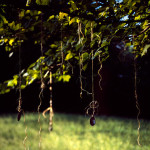The Foto Awards presented by Las Fotos Project: Kimberly Espinosa in Conversation with Bayley Mizelle
This week in honor of Latinx Heritage Month, we are celebrating a wonderful organization in Los Angeles, the Las Fotos Project, and The Foto Awards event taking place on October 23, 2021. Today we feature the work of Kimberly Estrada who received the Advocacy Youth Awardee. Advocacy Award is awarded for power in photojournalism or use of photography for community advocacy & social justice.
Las Fotos Project’s mission is to elevate the voices of teenage girls through photography and mentoring, empowering them to channel their creativity for the benefit of themselves, their community and future careers. The organization was founded in 2010 to introduce teenage girls to the transformational power of photography and advance positive change in the surrounding community.
 From the community of Koreatown, Kimberly Espinosa is a Zapotec community organizer and artist whose work reflects daily lived experiences, including identity, family history, and community. Growing up in Koreatown has been a beautiful experience for Kimberly to connect and honor their ancestral roots by sharing community spaces with other indigenous relatives to share dialogue and build collective initiatives. She is currently a participant in the Koreatown Storytelling Program, where she prepares to interview elders and continues to develop their passion for photojournalism. Kimberly intends to continue to engaging in oral history and story telling by documenting the stories of their relatives and community through creative mediums.
From the community of Koreatown, Kimberly Espinosa is a Zapotec community organizer and artist whose work reflects daily lived experiences, including identity, family history, and community. Growing up in Koreatown has been a beautiful experience for Kimberly to connect and honor their ancestral roots by sharing community spaces with other indigenous relatives to share dialogue and build collective initiatives. She is currently a participant in the Koreatown Storytelling Program, where she prepares to interview elders and continues to develop their passion for photojournalism. Kimberly intends to continue to engaging in oral history and story telling by documenting the stories of their relatives and community through creative mediums.
I. Inspiration & Community
Bayley Mizelle: Your work is greatly influenced by your life experiences, your family history and the closeness you have to your community as a community youth organizer. Can you talk about how working with your community or collaborating with your family and friends inspires or develops your art making?
Kimberly Espinosa: Art has been a tool for resistance, empowerment as well as community organizing for a long time. I remember working on projects in middle school that involved art making to advocate for migrant communities particularly Temporary Protected Status members of the community. From photography to producing a Know Your Rights series, coming together with others to be part of these initiatives encouraged me because we all had a significant role to contribute as we worked in our different capacities. Making art as a community has taught me so much about the importance of the art we create. I like to make art because I want to use it as a form to express gratitude and solidarity towards the communities that I have grown up as part of. That is always my hope, to show love and care for our communities who are still here.
BM: What are some ways that you share your work and creative practice with your community? / Do you have any dream plans for creating art opportunities for your peers and community one day?
KE: Yes! I would love to share opportunities for my peers and community to also have access to art and art making. I appreciate all the efforts happening in the community to make this accessible for youth like me. Although it is a dream to provide some sort of programming by the community for people to engage with art, I do not think I have to wait until then. I love inviting friends and others to participate in any upcoming program or project opportunity I learn about. I have really learned that art does not have to exist within an institution for it to be recognized as art. It can be so special to create with your friends and even family!
BM: How has learning your family history and lineage continued to influence your creative practice?
KE: A few months before starting to do photography more consistently, I was learning the Zapotec language from our family’s village during a class offered by a relative. During that time, I heard a lot of stories from my parents on the history of their hometown. From my mom’s side of the family, I especially learned a lot about the migration that occurred because of labor purposes. My grandpa was born in Oaxaca, Mexico, but their family had to relocate to Veracruz, Mexico where most of our family now resides. There was so much I was learning about my family, and I needed some method of documentation. In the beginning, I was mostly doing audio recordings, but later I started photography with Las Fotos Project. It was through the program that I found it very important for my photography to document connection with ancestral roots, reflecting on identity and what being part of a community can mean. A lot of the photographs I have taken have been in reflection with the grief I experience day to day from the passing of my dad and yearning to truly be home in our family’s homeland. I hope that what I create honors the people and memories loved ones and community spend together. I also hope that my art is a call for everyone to actively stand in solidarity with Indigenous families and communities.
II. Your Work & Practice
BM: How did you become involved with Las Fotos Project and Koreatown Storytelling Program?
KE: A lot was happening in my life when I came across the opportunity to join these programs. I was an active youth participant with the Koreatown Youth & Community Center organization when I heard about the call for youth to apply to the Koreatown Storytelling Program. I was planning to apply during the winter break, but I did not know what would happen in the following weeks. My dad and I got sick from COVID-19 just a couple of days after my winter break started, and so much changed after that. I missed the deadline of December 31st. A few days later, I received an email from one of the coordinators of the program reaching out to see if I was still interested as they heard about me from another applicant and remembered me from an email I had previously sent about my interest in the program. I let them know that I was still interested but that due to what was happening at home, I had missed the deadline to apply. At that time, my dad was admitted into the ICU, and home did not feel like a safe place anymore. All I wanted was to be back with my mom and dad like it always was. Weeks that felt like never-ending went by. My dad passed away on January 29, 2021. Throughout these very hard weeks at home, the program director and everyone else were very understanding and supportive. A couple of days after my dad passed away, I got an email from Las Fotos Project. I had previously filled out a student interest form located on their website after coming across their Instagram page a few months prior. Despite my interest to join the program right from the start, I had so much to think about. My dad was almost always the one to take and pick me up from wherever I needed to be, even if we used public transportation to commute. I decided to eventually apply as something else to keep myself distracted from the reality I was facing. Joining both of these programs has been a significant experience, and I hope it continues to be for many too.
BM: Can you talk about how organizations and programs like LFP and KSP are accessible and empowering for the creative youth?
KE: Having access to these spaces has been really great. The fact that other youth and I are able to have these kinds of resources makes me really happy because it means that we can tell our own stories. The most important aspect for me as a participant of these programs has been storytelling. From the start, I felt safe reflecting on identity and what it means to be part of a community. This is especially important in a space where one may often be vulnerable as one creates work around the experiences one has had. Becoming part of the Youth Advisory Council at Las Fotos Project has further allowed me to see the different approaches the organization takes to center the voices and needs of its students. I have found more than just a space to create within these programs, but I have also become part of these amazing communities of incredible human beings.
BM: Tell us about what you photograph.
KE: I began to do a lot more photography almost right after my dad passed away. Because of that, I really think this moment in my life has defined the photographs I decide to take and will most likely continue doing so. I cherish the opportunity to take portraits of people and still life photos of objects significant in their life. It can take a lot for a person to be able to stand in front of the camera, so I really appreciate every time someone trusts me to take their photo. Since I am still in high school, sometimes the most accessible subject to photograph is my mom. I have really enjoyed exploring documentary photography with my mom as my subject. Even though I have lived with her all my life, I still feel like capturing her through photographs has opened this almost like… like a new door to stories of her life. This component of storytelling has been so special to include in my art. Part of this storytelling has also been taking candid photographs of people in their environment. Taking photos of my nieces playing together has been one of my favorite experiences. As I photograph a lot of the people I am around and of my surroundings, I also grow together with them.
BM: How has working with mentors at LFP influenced how you create or your creative process/practice?
KE: My mentors have been so amazing to work with. While they have reached out to support with photo critiques and providing technique feedback, they have always reminded me how what I want to showcase is ultimately up to me. Rather than directing me to create in a certain way, they have truly let me take the lead on how I wish to approach my projects. Having this kind of support from them has made the overall process of creating much more accessible. I know they were always there to advocate for me, and that really encourages me to advocate for myself as well.
BM: Lastly, what’s something new you’ve recently incorporated into your art making process or daily creative routine? Do you create/photograph everyday?
KE: I recently joined the Self Help Graphics & Art Youth Committee where I am provided additional resources to use my art as a form of advocacy for community justice. Besides photography, I am learning how to use other art mediums to also engage in meaningful discussions and collaborative efforts to document the stories of our communities. Having this space to learn and create art projects by and for the community has been grounding and allowed me to envision how I can incorporate other forms of art with my photography. I think this is perfect because I can always learn from what I create. While I do my best to shoot with intention, sometimes taking a step back helps too. Life happens. As a current high school senior, being creative during high-stress moments also helps me take a moment to pause and reflect.
Bayley Mizelle currently serves as the Director of the Photographic Arts Council Los Angeles. In addition to her work in contemporary art and arts education in the fields of writing, photography, arts pedagogy, and artist consulting, Bayley has been closely involved with the Los Angeles photographic community, contemporary art galleries and artists’ studios; co-producing and co-curating events and exhibitions, collaborating with The Lucie Foundation for Month of Photography LA, as well as Frieze LA. She was a grantee of the Citizen Artist AmeriCorps (CAA) Teaching Fellow Grant & Excellence in Education Award in 2016, where she taught and developed arts educational programing in photography and creative writing for underserved inner city youth programs in Los Angeles.
Bayley received a Bachelor’s of Fine Art in Photography and Media with a Minor in Critical Studies for Creative Writing from the California Institute of the Arts (CalArts). Follow PACLA on Instagram: @photographicartscouncil_la
Posts on Lenscratch may not be reproduced without the permission of the Lenscratch staff and the photographer.
Recommended
-
Arnold Newman Prize: C. Rose Smith: Scenes of Self: Redressing PatriarchyNovember 24th, 2025
-
Celebrating 20 Years of Critical Mass: Cathy Cone (2023) and Takeisha Jefferson (2024)October 1st, 2025
-
Celebrating 20 Years of Critical Mass: George Nobechi (2021) and Ingrid Weyland (2022)September 30th, 2025
-
Celebrating 20 Years of Critical Mass: Amy Friend (2019) and Andrew Feiler (2020)September 29th, 2025
-
Celebrating 20 Years of Critical Mass: Jennifer McClure (2017) and JP Terlizzi (2018)September 28th, 2025

![CHILD OF ANCESTORS [FOTOSBYKIMBERLY]](http://lenscratch.com/wp-content/uploads/2021/10/CHILD-OF-ANCESTORS-FOTOSBYKIMBERLY.jpeg)
](http://lenscratch.com/wp-content/uploads/2021/10/HONORING-WITH-RESPECT-FOTOSBYKIMBERLY2.jpeg)
![REFLEXIÓN [FOTOSBYKIMBERLY]](http://lenscratch.com/wp-content/uploads/2021/10/REFLEXIÓN-FOTOSBYKIMBERLY.jpg)
![DAD'S MEMORY [FOTOSBYKIMBERLY]](http://lenscratch.com/wp-content/uploads/2021/10/DADS-MEMORY-FOTOSBYKIMBERLY.jpg)
![BIDAO' [FOTOSBYKIMBERLY]](http://lenscratch.com/wp-content/uploads/2021/10/BIDAO-FOTOSBYKIMBERLY.jpg)
![HOMEMADE [FOTOSBYKIMBERLY]](http://lenscratch.com/wp-content/uploads/2021/10/HOMEMADE-FOTOSBYKIMBERLY.jpeg)
![INNER CHILD [FOTOSBYKIMBERLY]](http://lenscratch.com/wp-content/uploads/2021/10/INNER-CHILD-FOTOSBYKIMBERLY.jpg)















































